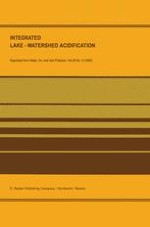1985 | OriginalPaper | Chapter
Influence of Geology on Lake Acidification in the ILWAS Watersheds
Authors : Richard April, Robert Newton
Published in: Integrated Lake-Watershed Acidification
Publisher: Springer Netherlands
Included in: Professional Book Archive
Activate our intelligent search to find suitable subject content or patents.
Select sections of text to find matching patents with Artificial Intelligence. powered by
Select sections of text to find additional relevant content using AI-assisted search. powered by
Three lake-watersheds in the Adirondack Mountains of New York State, underlain by similar granitic bedrock and receiving similar levels of acidic deposition, were found to have very different surface water alkalinities. The chemical differences appear to be due to differences in the unconsolidated surficial materials in the basins. Woods Lake watershed (mean lake outlet pH of 4.7) is covered by thin till with many interspersed bedrock outcrops. The thinness of these surficial deposits (average depth 2 m) limits the amount of deep percolation of water and thus contact with alkalinity-producing inorganic horizons. In contrast, Panther Lake watershed (mean lake outlet pH of 6.2) is covered by thick glacial till (average depth 24 m). Here more of the precipitation comes in contact with the alkalinity-producing materials. Sagamore Lake watershed is much larger and has areas of both thick and thin deposits and lake outlet pH values intermediate to those of Woods and Panther lakes.The soils in all three watersheds are dominated by quartz, potassium feldspar and sodic plagioclase with minor amounts of hornblende and other heavy minerals. The dominant clay mineral is vermiculite. Chemical evidence suggests the present rate of mineral weathering is less than the long-term rate in Woods Lake watershed while in Panther, the present rate may have increased relative to the long-term rate.
